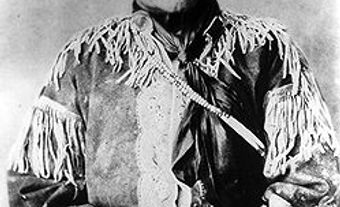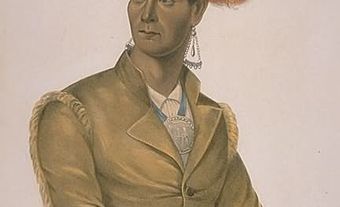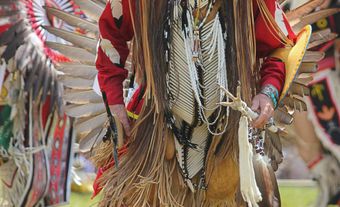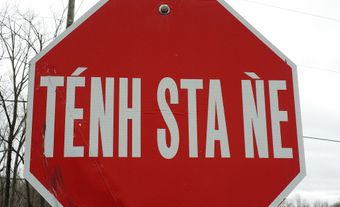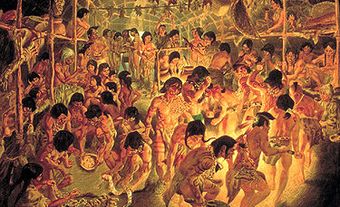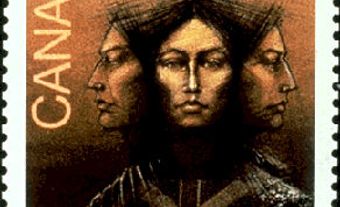
Early Life and Education
Joseph Brant’s parents were Margaret Onagsakearat (circa 1715-1779) and Peter Tehowaghwengaraghkwin (1707-1743), both Protestants. After Peter died while the family was living on the Ohio River, Margaret returned to the Mohawk Valley, in northern New York, with her infant Joseph and his sister Mary.
The family settled at Canajoharie near Little Falls, New York. Margaret then married Nickus (Kanagaradunkwa) Brant, a Mohawk believed to be part Dutch, who lived and dressed in European style.
Among the Mohawks, the Brants were a family of distinction. Margaret was reportedly a granddaughter of Mohawk chief Theyanoguin (also known as King Hendrick, Hendrick Peters, or White Head).
In 1761, Sir William Johnson, Brant’s British military commander and his sister’s common-law husband, sent him to Moor’s Indian Charity School (the forerunner of Dartmouth College) at Lebanon, Connecticut. He stayed for two years. His teacher Eleazar Wheelock described him as “of a sprightly genius, a manly and gentle deportment, and of a modest, courteous and benevolent temper.”
In Connecticut, Brant learned to speak, read, and write English. Pontiac’s Rebellion in 1763 thwarted his plans to attend King’s College (now Columbia University) in New York City.
Ally of the British
Joseph Brant saw action during the Seven Years’ War and was with Sir William Johnson in the expedition against Fort Niagara in 1759.
For many years, he acted as an interpreter for Johnson and his successor in the British Indian Department, Guy Johnson. He also aided missionaries in teaching Christianity to the Indigenous people and he helped translate religious materials into Mohawk (See Kanyen’kéha: Mohawk Language).
American Revolution
With the outbreak of the American Revolution in 1775, Joseph Brant immediately rallied to the royal cause and, in 1775–76, he visited England with Guy Johnson to argue for Mohawk interests.
Brant fought throughout the war with an Indigenous-Loyalist band. He was greatly admired as a soldier and was commissioned captain by the British in 1780; however, he fought as a Mohawk war chief. He was considered the perfect soldier with remarkable stamina. He inspired such confidence that non-Indigenous fighters sometimes requested a transfer to join him.
Beginning in 1783 and through the mid-1790s, Brant worked to form the Western Confederacy, a united group of Haudenosaunee (Iroquois) and western Indigenous peoples, created to block American expansion westward.
His dream ultimately was undermined by factionalist jealousies among the First Nations, by American opposition, and finally by British betrayal. Although Brant traveled to London in November 1785 to ask King George III for help to defend the Western Confederacy from attack by the Americans, the British government gave no promise of support.
Grand River Settlement
In the fall of 1784, following the American Revolution, Joseph Brant led the Mohawk Loyalists and other Indigenous peoples to a large tract of land on the Grand River; it was granted to the Six Nations in compensation for their losses in the war (See alsoHaldimand Proclamation). This became Brant’s Ford (now Brantford, Ontario), named after him.
Because their tract of land was too small for hunting, Brant feared that Indigenous people would have to learn agriculture to survive. To provide income, he hoped to lease or sell land to non-Indigenous people. A complicated controversy with the government arose over the nature of Indigenous land tenure, with Brant and other Mohawk leaders fighting for the right of their people to own the lands on which they lived. At the same time, some of the Grand River Indigenous people expressed discontent over disposition of the money.
Essentially, the government of Upper Canada refused to concede land title to the Mohawk in the Grand River Valley during Brant’s lifetime. For decades, from 1776 to his death in 1807, Brant fought in vain with the British and Upper Canada governments for the rights of his people to obtain title to the lands of the Grand River Valley.
Like his sister Mary, Brant became known for his diplomatic work, especially as a leader of Indigenous tribes who fought for the right to remain on their ancestral lands.
In his later years, Brant lived quietly in his magnificent house at Burlington Bay and translated parts of the Bible into Mohawk (See Kanyen’kéha: Mohawk Language).
Personal Life
In 1765, Brant settled at Canajoharie in the Mohawk Valley (now upper New York State). That year, he wed his first wife Margaret (“Peggie”), an assimilated slave and the daughter of unknown Virginia planters. They had two children: Isaac, who died after a fight with his father (by most accounts, Joseph Brant was acting in self-defense), and Christina.
After Margaret died of tuberculosis in 1771, Brant wed Margaret’s half-sister Susanna two years later. In 1778, she also died of tuberculosis. Little is known about her.
In 1780, Brant married Catherine (Adonwentishon) Croghan, daughter of Irish Indian agent George Croghan and a woman from a prominent Mohawk family. They had seven children: Joseph, Jacob, John, Margaret, Catherine, Mary and Elizabeth.
Elizabeth, born in 1796, married William Johnson Kerr, grandson of Sir William Johnson and Brant’s sister Mary. Her son later became a Mohawk chief.
Brant’s son John, who became superintendent of the Six Nations circa 1826, distinguished himself in the War of 1812.
DID YOU KNOW?
Five years before moving to Burlington, Ontario in 1784, Joseph Brant began to own black slaves, possibly as many as 30 people. While still living on the United States side of the border near Niagara, he bought a kidnapped black slave girl named Sophia Pooley, whom he claimed to have adopted as “one of the family.” He brought her and other slaves with him when he moved to Burlington Bay, where she hunted deer with his children and travelled with the family for many years.
Death
Joseph Brant died on 24 November 1807 at Wellington Square (now Burlington). Buried at his Burlington home, he was later reinterred, along with the remains of his son John, beside Mohawk Chapel in Brantford, ON in November 1850. The Masonic Foundation of Ontario erected a commemorative plaque there in 1984.
Legacy
Although influential as a British civil servant and interpreter, Joseph Brant also gained respect and high praise as a fine soldier and warrior. After the American Revolution ended in 1783, he fought for Indigenous land rights as a Mohawk and Six Nations leader.
In Ontario, Brantford and the county of Brant are named after Joseph Brant. In 1886, the Joseph Brant Memorial statue, designed by architect John Turner, was unveiled in Victoria Square in Brantford.
A Government of Canada historic plaque commemorating Brant stands in Six Nations Veterans Park in the village of Ohsweken, near Brantford. A portrait of him by William Berczy, circa 1807, is in the National Gallery of Canada collection.
Joseph Brant Hospital, opened in 1961 in Burlington, ON, is named after him.

 Share on Facebook
Share on Facebook Share on X
Share on X Share by Email
Share by Email Share on Google Classroom
Share on Google Classroom


